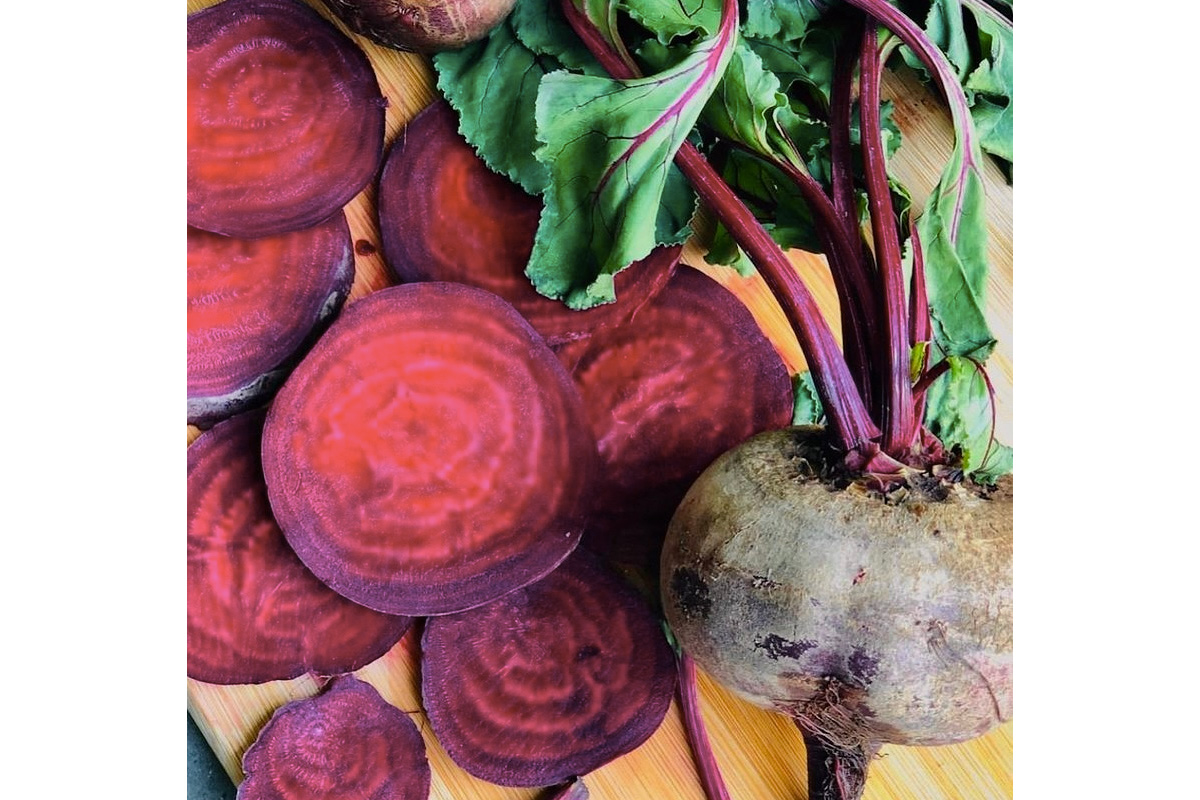Deep Purple
Words and Photos by Shubhra Ramineni
There’s a color that is currently trending with interior designers, looking to create bold, unexpected accents on walls, cabinets and trims. In the kitchen, that color is also a noteworthy winter vegetable: beets.
As the welcome cooler weather arrives, I will be making room in my fridge for these beautiful, dark burgundy vegetables and a fermented drink made from them. Many may think it looks like wine, but it’s a healthy Indian libation called kanji, made from beets.
Beets come in many varieties and a range of vibrant colors with minimal differences in taste — from deep red or rich purple, which are the most common and have a more earthy flavor, to white, which are a bit sweeter. They also come in golden yellow and, my favorite, candy-striped. When you cut into this variety — called chioggia — it reveals a candy-cane effect of alternating red and white concentric stripes. It’s hard to believe its magical design is natural! It does fade after it cooks, so this variety is most appreciated when enjoyed raw.
The leafy tops can be enjoyed in a salad, or cooked as you would other greens such as spinach or collards. The stems are not tough and have a mild flavor and can be chopped and added to a salad or cooked dish.
Beet skins are very thin and contain many of the nutrients the vegetable is known for, including fiber. Although the skins are edible, it is common to peel them before or after cooking the root. A key thing to remember when preparing beets: make sure you don’t use your favorite cutting board, as the beets will likely leave behind reddish-purple stains.
Beets are fun and easy to grow in your own backyard. In Houston, September and October are the best time of year to plant beets so they will be ready to harvest in December. My daughter enjoys gardening, and she asked me to be the "garden parent" for her fourth-grade class. We planted our first seeds in the school garden beds in the fall. I included beets, and it was magical watching the students harvest the small dark globes from the soil. Even if you only have access to a medium or large pot on your porch, you can try your luck and plant a few beet seeds.
Beets are enjoyed around the world in different ways. They can be eaten raw, roasted, boiled, steamed, pickled or juiced. A common preparation on restaurant menus is to pair beets with goat cheese crumbles and mixed greens, which is delicious and can be easily replicated at home. I prefer to roast beets, cutting them into 1⁄4-inch slices, drizzling them with olive oil and cooking them until fork-tender, about 45 minutes. The peel is easily removed after they’ve cooled. The warm beets are so good on top of a salad. Beet hummus is delicious and vibrant. I peel and roast the beets in my toaster oven, and then blend with cooked chickpeas, lemon, garlic, and tahini. I like to dip carrot sticks in this beautiful and tasty dip.
In the southern parts of India, beets are cut and sautéed into a vegetable dish called beetroot poriyal. Mustard seeds are tempered in oil to bloom their flavor. Curry leaves, green chilies, diced onion and ginger are tossed in. Then, diced or grated beets are added, along with turmeric, salt and shredded coconut and cooked until tender. This dish can be enjoyed with rice or Indian flatbreads such as chapati.
I don’t always drink fermented beverages, but when I do, I prefer kanji, which my mother taught me how to make. This refreshing Indian drink, most common in northern India, is high in probiotics and antioxidants and has many potential health benefits such as improving gut, skin and heart health and increasing energy levels. Traditionally, kanji is made with black carrots, which are hard to find in the United States, so the next best thing is beets, which have a similar color and taste (and express a pungent aroma that I ran away from as a child, but happily embrace now).
If you like kombucha, I think you will love kanji! I advise you to sip it in moderation until you see how your body adjusts to it. I hope you put that bundle of burgundy beets in your basket on your next grocery trip!
Kanji (Fermented Beet Drink)
Makes 5 cups
This Indian fermented beet drink is best enjoyed chilled, and has a distinct aroma and tart taste, so you will either love it or hate it! Sip it and reap the health benefits. All you need is fresh beets, black mustard seeds, salt, red pepper, a BIG pitcher of water and the patience to let the drink ferment on the counter for three days. It will last in the fridge for two weeks.
3 beets
3 t. ground black mustard seeds
2 t. salt
1/2 t. ground red pepper (cayenne)
5 c. water
PREPARATION
Wash and peel the beets. Cut off the ends. Slice the beet into 1/4-inch circles. Cut each circle in half. Put the cut beets in a large pitcher. Add the ground black mustard seeds, salt and ground red pepper. Add the water. Mix together. Cover with plastic wrap. Place the pitcher by a sunny window for three days. You will see the water start to turn a beautiful deep burgundy and bubbles and froth will start to form on top, which indicates the fermentation process has begun. You can take a peek, but keep it covered. After 3 days, mix well and put the pitcher in the fridge
to chill. Sip as small amount as you like. You can also munch on the beets. Important note: If you do not see any fermentation on the top of the pitcher by day three, it is possible the house was too cold, or there was not enough sunlight. At this point, you should discard the contents.





